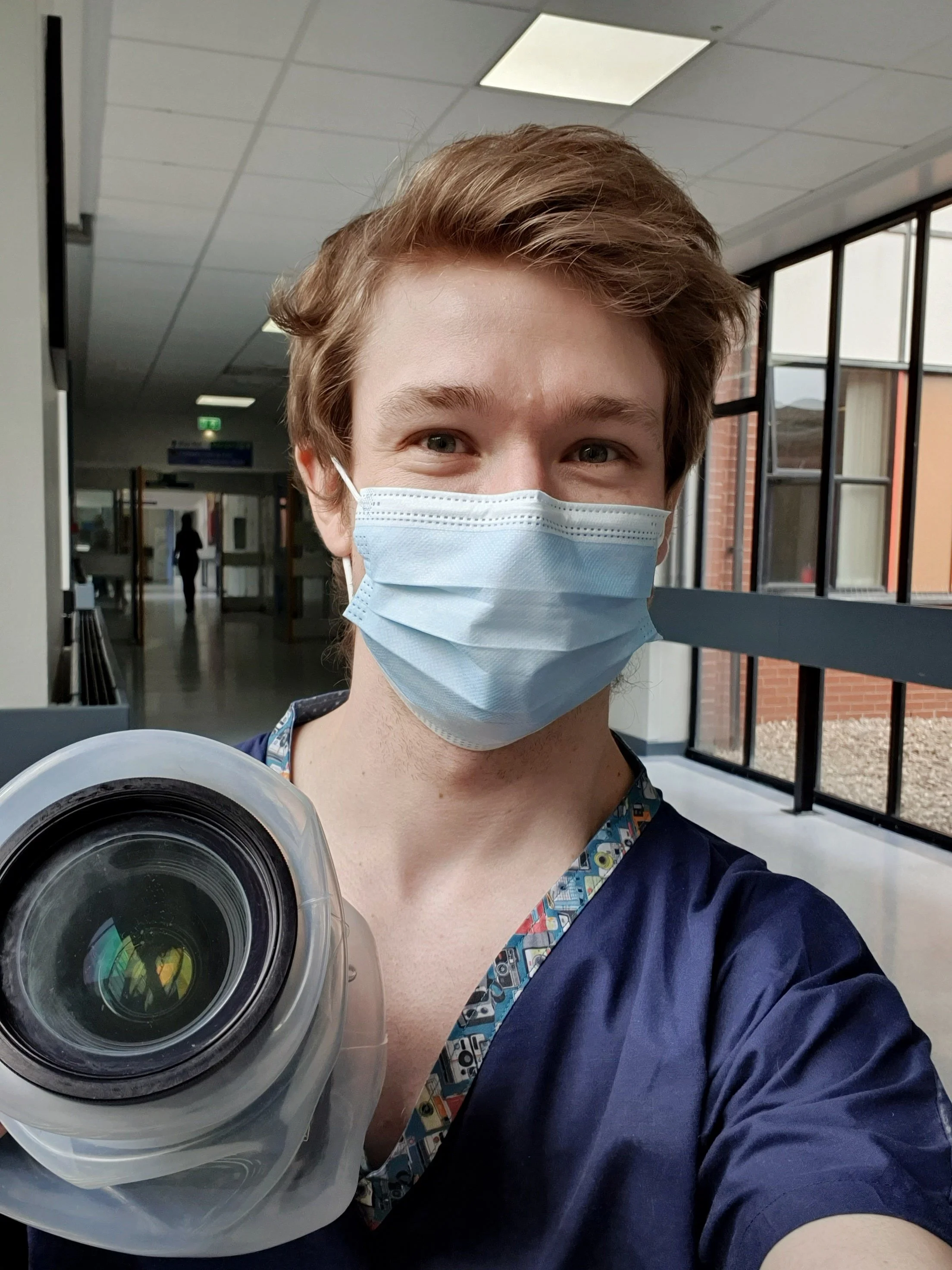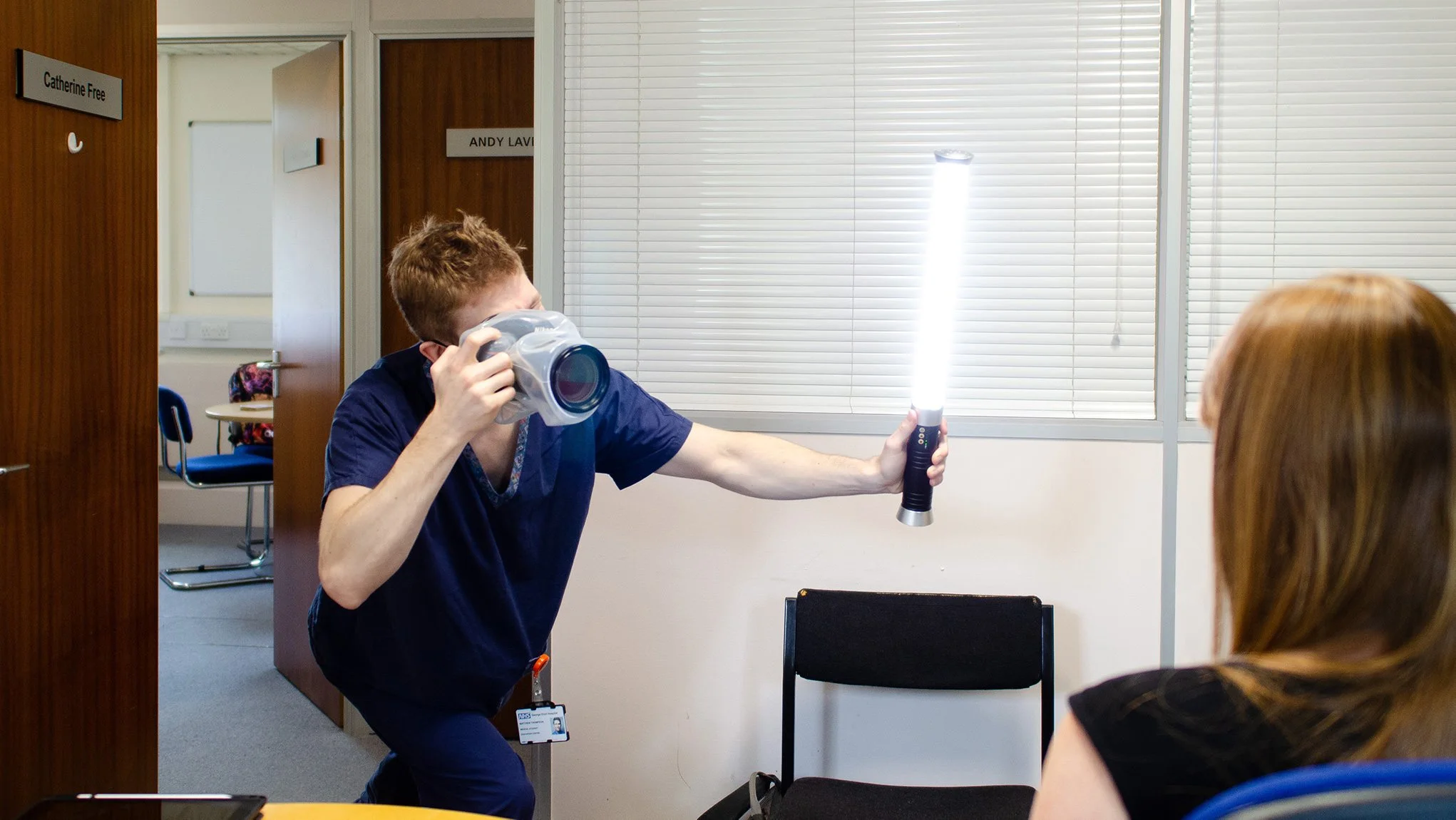Portraits in a Pandemic
Originally intended to be published in a journal.
During the UK’s first wave of COVID-19, I photographed 67 NHS staff in their places of work at George Eliot Hospital and talked to them about their pandemic experiences. As a graduate entry medical student, I was well placed to record the unfolding pandemic from two perspectives. While teaching and placement were paused during the first lockdown, I joined many other healthcare students across the country in providing clinical support on the wards. My insight on the respiratory (COVID) ward revealed a variety of roles contributing to patient care that I had not previously encountered or been taught about. After sourcing approval from the hospital and Warwick Medical School management, I began creating portraits of staff around me as a gesture of thanks. Before long, this personal project became an endeavour to recognise every role affected by the pandemic.
To protect myself and others, I drew on my experience as an underwater photographer and was well supported by the Infection Control team. This article describes how the project was completed in a sensitive healthcare environment under challenging and evolving circumstances.
Titled ‘Humans of the Pandemic’, my project places a spotlight on a wide variety of roles, specifically including those in little known roles, in their live work environments. I set out to create one or two portraits of each individual; one in all their personal protective equipment (PPE) and if possible, one with their face revealed. They would later receive post-processed, high resolution digital copies for free. During each session, I informally asked how they were feeling and how their work had changed.
Appropriately protecting myself and my equipment was crucial to minimising contamination and developing trust with management and participants themselves. As I chose to photograph participants in their active places of work, I encapsulated my camera in a waterproof housing. My underwater experience with the product by Outex allowed for effective cleaning with sterilising wipes or soap and water between locations. This allowed a suitably deep clean without harming the electronics or missing spots between buttons.
Natural light was harnessed where possible, but additional light was necessary for almost all participants, even where windows were present. I specifically sourced a battery-powered continuous light with a cylindrical form that could be handheld and easily disinfected by sterilising wipes. Continuous light was chosen over flash to minimise distraction to patients and staff in the clinical environment. This setup provided a mobile and minimally-contaminable method for travelling around the hospital. The Infection Prevention & Control Team endorsed this approach and requested more information to inform their future advice and practice.
I changed my PPE wherever appropriate, as indicated by hospital and national guidelines at the time for each location. As the project was completed over 9 days between April and August 2020, evolving guidance can be seen in the level of PPE between participants.
Ensuring confidentiality for patients and other staff was another absolute priority. A wide aperture of f/1.4 was chosen for almost all portraits to minimise depth of field and risk of capturing identifying information. This also helped make the most of the available light. A focal length of 35mm was used for the majority of portraits due to restricted space. This close proximity also meant I could use the handheld light to illuminate the subject myself.
Most participants were recruited at random as I introduced myself to different teams. Some were invited through working interactions and other participants introduced themselves, with word of mouth helping the project grow beyond my usual places of work. I sought a diverse selection of participants across gender, race, and role, but was conscious not to exclude potential subjects by prioritising this or refuse eager bystanders who hoped to engage with the project. Some roles therefore hold more representatives than others, while staff invited from other specialities did not wish to participate. All participants signed a model release and most answered a short questionnaire about their feelings and adaptations that was sent out after. These answers were summarised and accompany the portraits.
Besides encountering a front-focussing issue with my Sigma 35mm ART lens early in the project that was solved using the Sigma USB dock, most of the photography went smoothly. An ISO around 500 was typically chosen to facilitate a shutter speed over 1/200th second to minimise blur from holding the camera and light in each hand. Increasing noise was an acceptable trade-off for a sharp image, particularly as I tried to interrupt each participant for as little time as possible. The majority of post-processing including exposure and contrast was performed in Adobe Lightroom Classic, with more challenging edits made in Adobe Photoshop CC.
Unfortunately, as teaching recommenced at university, I felt the need to stop the growing project sooner than I would have liked. Recording such a large number and wide variety of staff in their place of work, across an NHS district general hospital, during unprecedented times was a bittersweet learning experience.
As a medical student and photographer I gained a unique insight, education and appreciation from my interactions, in the midst of a broadly harrowing collective experience. I heard raw expressions of fear, sorrow, and pride, while deepening my understanding of how the hospital-wide team fit together. Almost everyone felt afraid or worried; mostly about passing the virus to their family. Many felt uncertain and overwhelmed. Some had been redeployed to new roles, returned from retirement, or joined the team after their usual teaching or work was halted. However, everyone expressed admiration and pride in their team and the NHS for adapting, coping and supporting each other through the evolving unknown.
When asked how they felt the NHS had been affected, concerns about overwhelming pressures on its staff and services, even before the pandemic were frequently voiced, often with worries over future mental health and support. Underappreciated and undervalued were common feelings, along with hopes that the renewed recognition may influence a rise in pay. Numerous clinicians commented on how reduced admittance, particularly to the emergency department resulting from public fears of attending hospital, both highlighted how services had been ‘abused’ in the past and were likely to lead to more serious attendees later on as early or mild conditions progressed without treatment. Despite fears over future knock-on effects of cancelling services, most felt optimistic that the NHS will adapt, albeit ideally with increased support. Some necessitated adaptations such as streamlined discharging and technology adoption were seen as overdue positives.
Feeling recognised and validated was one of the most common thoughts I heard participants say they were grateful for. I hope all NHS staff pictured, or not, will receive the recognition they deserve for their strength and sacrifice during the pandemic and beyond.
The exhibition for Humans of the Pandemic was unveiled in November 2021, with 20 beautifully framed prints adorning the walls of George Eliot Hospital for the foreseeable future.
Take a look at the exhibition and press release by clicking here.




